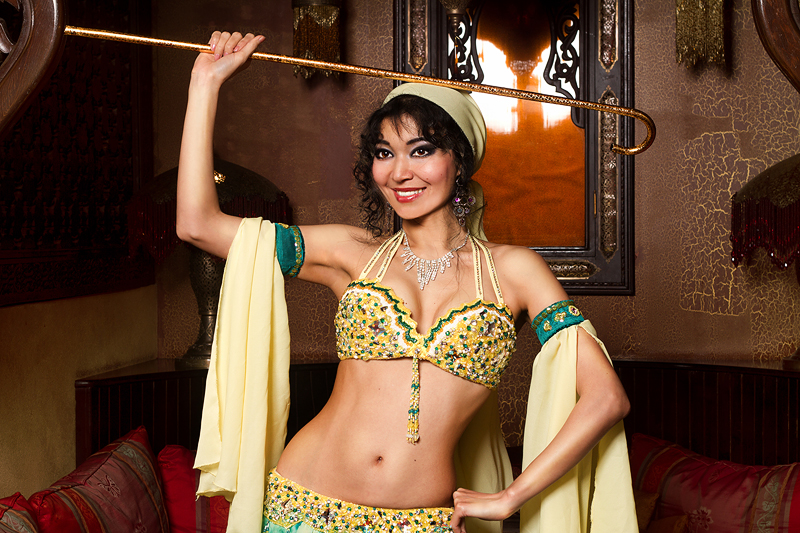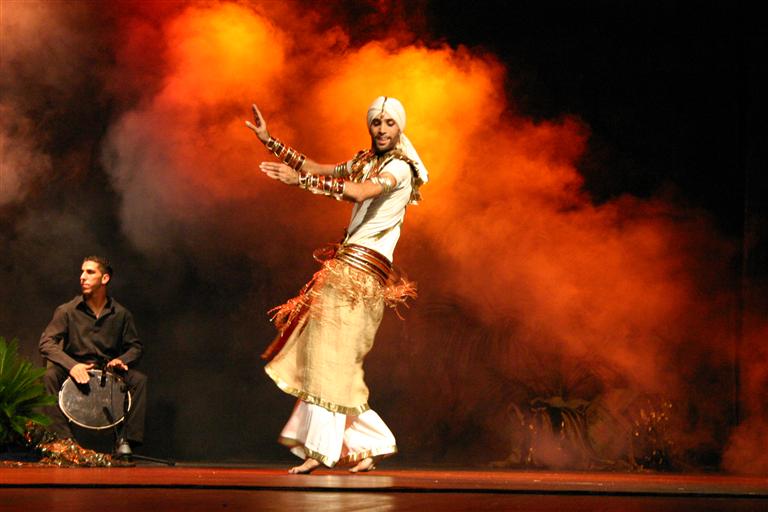
by Saeeda | Oct 8, 2012 | Health benefits
Bellydance and pregnancy. In ancient times, bellydance was a ritual accompaniment of labors, and its movements were seen as an imitation of labor pains. So far, in some Asian and African regions, such methods of oriental dance as retraction and stretching the abdomen are used as a preparation for childbirth for young women.
It is known that during pregnancy the abdominal muscles have a particular load: abdominal skin and muscles are stretched several times. If before the pregnancy woman have never trained these muscles, after the birth it is almost impossible to bring the abdomen to its previous form, and while carrying a child they are experiencing a huge load. However, Oriental dancers after giving birth recovering very quickly: the trained muscles can easily revert to the previous ideal waist. Intercostal and oblique muscles of women, who do belly dancing, are especially strong, and in fact they provide a slender waist. That is why modern doctors advise this ancient art, called bellydancing.
Some of the techniques involved in preparing for childbirth, are built on based technique of certain belly dance movements: these are the most natural movements inherent in women for their labors. But the most effective and successful in this respect is the full range of the movements of this archaic dance, which allows toning all abdominal muscles. It is safe for pregnant women, especially if they start belly dancing in early stage of the pregnancy, it eases back pain, and helps maintain flexibility and a positive impact on the process of childbirth. Rolling rhythmic contractions of abdominal muscles makes it easier, and abdominal movement promotes relaxation and concentration, so important at this crucial moment.
For pregnant women bellydancing is an ideal and natural physical exercise, which in addition to preparing for childbirth has a positive effect on the unborn child, focusing on the future mother’s abdomen.
![Classes]()
by Saeeda | Sep 30, 2012 | Get in touch
Saeeda belly dance school
Experience the magic of belly dancing
Enrol Now
Studio Classes
Saeeda is based in London and teaches group classes as well as private. Her classes are suitable for all levels and body types, including complete beginners.
Classes are available for both, club members and non-members.
- Mondays: 8:00 – 9:00 pm
Beginners (level 1) – Fitness First Lewisham
67-71A High Street, Lewisham, London SE13 5JX view on map
- Tuesdays: 8:00 – 9:00 pm
Improvers (level 2) – Fitness First Camden
128 Albert Street, Camden, NW1 7NE view on map
Please contact Saeeda for details and fees.
Contact details:
E-mail: saeedadance@gmail.com
Phone: 07896338460

by Saeeda | Sep 30, 2012 | Get in touch
 Saeeda was born and brought up in the East. She was a little girl when her mother first led her to a belly dancing show. From this moment this dance conquered her and became the guiding light in her life. In the East, she went to dance school. There, she learnt ballet, contemporary dance and different dances of the world’s cultures – from the fiery Spanish to the lyrical Persian. Her mother wanted Saeeda to be a ballerina, but she secretly danced her belly dancing. She is now based in London and teaches oriental dance.
Saeeda was born and brought up in the East. She was a little girl when her mother first led her to a belly dancing show. From this moment this dance conquered her and became the guiding light in her life. In the East, she went to dance school. There, she learnt ballet, contemporary dance and different dances of the world’s cultures – from the fiery Spanish to the lyrical Persian. Her mother wanted Saeeda to be a ballerina, but she secretly danced her belly dancing. She is now based in London and teaches oriental dance.
Saeeda has had a university education in the specialty »Oriental studies and International Relations«, which enables her to explore the East in all its aspects. Her professional experience and fluency in 5 languages, including Turkish, Chinese, English, and Russian helped her to further explore ethnic and historical roots, and the specifics of the dances of peoples of the East.
Saeeda lives in a world of dance imagery, and all her free time she spends on self-improvement. In this she is actively supported, encouraged and mentored by famous dancers, great masters, choreographers and teachers, such as Fifi Abdou, Randa Kamel, Jillina, Aziza, Sadie, Ansuya, Leyla Jouvana, Shafeek and Tara Ibrahim, Khaled Makhmoud, Ozgen and Akaysha.
Saeeda is deeply assured that the bellydance classes replace all the existing methods and technologies of women`s health and beauty support. Moreover, she believes that bellydance is more efficient than all of these methods as a whole. Saeeda, during her long career, noticed that people can easily combine this passion with any lifestyle.
Saeeda is a gifted teacher, who teaches this dance to people of all ages and body types. She can explain the fundamentals of the dance in words of one syllable and teach in a short period magnificent oriental dance. Learning this dance, making it your partner in life, you will forget the way to doctors, dieticians, and various would-be, self-constituted fitness “gurus”.
In the first lesson, you will understand how seriously and professionally she refers to her lifetime passion. Saeeda dances both classical Egyptian style and her own dynamic, modern style.
Leonardo da Vinci said: »Bad is that student who did not surpass his teacher«.
And Saeeda`s motto: »Bad that teacher, whose disciples did not surpass him!«
Do not miss your chance and e-mail Saeeda for your FIRST FREE LESSON.

by Saeeda | Aug 31, 2012 | World of Belly Dance
In this type of dancing, which to those who are curious and are surprised there are indeed Male Belly Dancing, has a curious history linked with culture, subjugation and the usual hate and prejudice we read a lot more often. Documentation on Male Belly Dancing, as it is, is scant and tedious to gather, as most are anecdotal and mainly from the present – yet we see ancient Egyptian tombs with paintings – samples here, showing people in those poses typically done in belly dancing (though we’re not sure if they’re actually male).
However, we can always start, theoretically speaking, that dancing itself must have started during unrecorded times when people – the old, young, men and women alike – gathered together to celebrate events and even the ordinary happenings in their lives. People then, as most of us nowadays, could have found means to express physically their joyfulness and other emotions, of which in dancing can be very well expressed in a more authentic manner. The celebrations, with concomitant festivities, must have been continued periodically, such that traditions from them were then developed in time.
These traditions, including that of male belly dancing, have continued to flourish for many, many more years that passed, that everybody in the community would participate in the dancing. We recognize here the origins of folk dancing, of which belly dancing has one its roots. And people from the Middle East, and Africa, where belly dancing is believed to have originated, apparently don’t see much problem from men doing belly dancing in modern times, as long as they’re doing it “folkloric” style.
And available documents show that men have been doing belly dancing, which can be gleaned from folk dancing, or what’s known as “raqs baladi” in Arabic. Male Belly Dancing is most particularly familiar, historically in Turkey. During the long history of the Ottoman Empire, “rakkas” or male belly dancers supplied the need for Ottoman men to watch something visually artistic and pleasing – as women were generally not around during social and entertainment life. Rakkas maybe either “kocek (or kocheks)” or “tavsan oglan,” most of which, even to-date, maybe seen performing during Ramadan.
The Koceks, who would usually wear women’s garb, and with long, flowing hair were described as: “young boys who were sensuous, attractive, effeminate, and carefully trained in music and dance. Their dancing was sexually provocative and impersonated female dancers. It incorporated ladylike walking, finger snapping (a special two-handed finger snap), slow belly movements, suggestive gestures, acrobatics, and playing wooden clappers called campara or, in later times, metal cymbals called zills. The boys danced as long as they stayed good looking and could hide their beards. The dancing boys were an acceptable substitute for the prohibited women dancers.” They faded into relative obscurity after they were officially banned in 1856.
The tavsan oglan (“rabbit boy”) usually have “charming little hats” and “tight pants,” who historians note might have come from the islands in the Aegean and Marmara regions. Most worked as bartenders, too, in meyhanes (traditional restaurants serving hors d’oeuvres – meze, and Turkish beverage – raki).
The presence of these male belly dancers during those historical periods reflect Turkish society then, when men and women were strictly segregated, and where men dominated all aspects of life. Even celebrations, including those in weddings then, have separate functions for men and women, thus these male belly dancers easily supplied what was lacking and missed.
Turkish Male Belly Dancing also had its counterparts in Egypt, where they were around until around mid 19th century. W.E. Lane’s book “Manners and Customs of the Modern Egyptians” and Gustave Flaubert’s “Travels in Egypt” describe these dancers extensi








Recent Comments